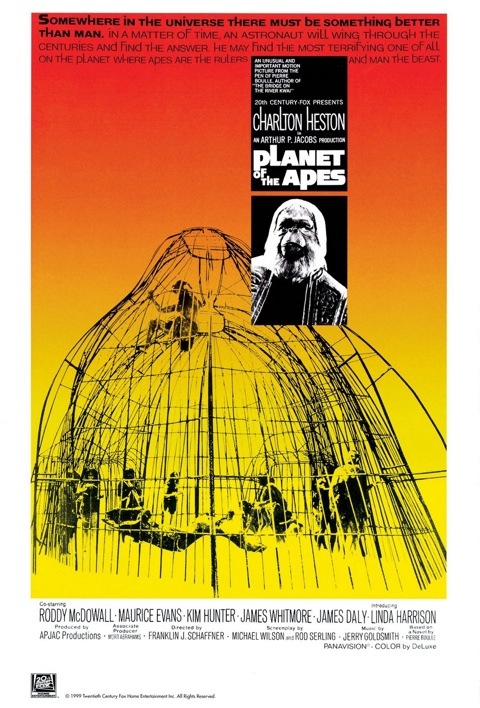Planet of the Apes
Storyform for the Humans as Protagonists
SYNOPSIS: "An astronaut crew crash lands on a planet in the distant future where intelligent talking apes are the dominant species, and humans are the oppressed and enslaved." Synopsis source: IMDB.com
Planet of the Apes can be interpreted as having two very different storyforms. In the first storyform Taylor and crew come to disrupt the status quo and are as seen as Antagonists. The second (shown below) sees Taylor and crew as Protagonists with the intention of taking over. For a detailed explanation, please see the Planet of the Apes Notes.
Story Dynamics
8 of the 12 essential questions
Main Character Resolve: Steadfast
Main Character Growth: Stop
Main Character Approach: Do-er
Main Character Mental Sex: Female
Story Driver: Action
Story Limit: Optionlock
Story Outcome: Failure
Story Judgment: Bad
Overall Story Throughline
Can Taylor "fit" in a planet ruled by Apes?
Overall Story Throughline: Universe
Overall Story Concern: Present
Overall Story Issue: Attempt vs. Work
Overall Story Problem: Protection
Overall Story Solution: Inaction
Overall Story Symptom: Reevaluation
Overall Story Response: Evaluation
Overall Story Catalyst: Attraction
Overall Story Inhibitor: Prerequisites
Overall Story Benchmark: Past
Overall Story Signpost 1: Past
Overall Story Signpost 2: Progress
Overall Story Signpost 3: Future
Overall Story Signpost 4: Present
Main Character Throughline
Taylor
Main Character Throughline: Physics
Main Character Concern: Learning
Main Character Issue: Preconditions vs. Prerequisites
Main Character Problem: Non-Acceptance
Main Character Solution: Acceptance
Main Character Symptom: Reevaluation
Main Character Response: Evaluation
Main Character Unique Ability: Strategy
Main Character Critical Flaw: Work
Main Character Benchmark: Understanding
Main Character Signpost 1: Doing
Main Character Signpost 2: Obtaining
Main Character Signpost 3: Understanding
Main Character Signpost 4: Learning
Influence Character Throughline
Dr. Zaius/Landon
Influence Character Throughline: Psychology
Influence Character Concern: Conceiving
Influence Character Issue: Deficiency vs. Permission
Influence Character Problem: Protection
Influence Character Solution: Inaction
Influence Character Symptom: Production
Influence Character Response: Reduction
Influence Character Unique Ability: Need
Influence Character Critical Flaw: Investigation
Influence Character Benchmark: Conceptualizing
Influence Character Signpost 1: Being
Influence Character Signpost 2: Becoming
Influence Character Signpost 3: Conceiving
Influence Character Signpost 4: Conceptualizing
Relationship Story Throughline
Man's Nature/Place
Relationship Story Throughline: Mind
Relationship Story Concern: Conscious
Relationship Story Issue: Doubt vs. Investigation
Relationship Story Problem: Protection
Relationship Story Solution: Inaction
Relationship Story Symptom: Possibility
Relationship Story Response: Probability
Relationship Story Catalyst: Appraisal
Relationship Story Inhibitor: Permission
Relationship Story Benchmark: Memory
Relationship Story Signpost 1: Preconscious
Relationship Story Signpost 2: Subconscious
Relationship Story Signpost 3: Conscious
Relationship Story Signpost 4: Memory
Addditional Story Points
Key Structural Appreciations
Overall Story Goal: Present
Overall Story Consequence: Conscious
Overall Story Cost: Conceiving
Overall Story Dividend: Learning
Overall Story Requirements: Past
Overall Story Prerequisites: Memory
Overall Story Preconditions: Conceptualizing
Overall Story Forewarnings: Understanding
Plot Progression Visualizations
Dynamic Act Schematics
OS:  MC:
MC:  IC:
IC:  RS:
RS: 




